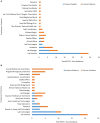Field Epidemiology and Laboratory Training Program, Where Is the L-Track?
- PMID: 30283768
- PMCID: PMC6156269
- DOI: 10.3389/fpubh.2018.00264
Field Epidemiology and Laboratory Training Program, Where Is the L-Track?
Abstract
Background: Modifications of the Field Epidemiology Training Program (FETP) curricula to include a laboratory track (L-Track), to become Field Epidemiology and Laboratory Training Program (FELTP), began in 2004 in Kenya. The L-Track offered candidates training on laboratory competencies in management, policy, quality systems, and diagnostic methods as well as epidemiology, disease surveillance and outbreak response. Since then several FELTPs have discontinued the L-Track and instead offer all candidates, epidemiologists and laboratorians, a single FETP curriculum. Reasons for these changes are reported here. Methods: A questionnaire was sent to directors of 13 FELTP programs collecting information on the status of the programs, reasons for any changes, basic entry qualifications, source institutions and where residents were post enrollment or after graduation. Data from previous CDC internal assessments on FELTP L-Track was also reviewed. Results: Out of the 13 FELTPs included, directors from 10 FELTPs sent back information on their specific programs. The FELTPs in Kenya, Mozambique, Cameroon and Kazakhstan and Mali have discontinued a separate L-Track while those in Ghana, Georgia, Nigeria, Rwanda, and Tanzania continue to offer the separate L-Track. Reasons for discontinuation included lack of standardized curriculum, unclear strategies of the separate L-Track, and funding constraints. Two countries Kenya and Tanzania reported on the career progression of their graduates. Results show 84% (Kenya) and 51% (Tanzania) of candidates in the FELTP, L-Track were recruited from national/regional medical health laboratories. However post-graduation, 56% (Kenya) and 43% (Tanzania) were working as epidemiologists, program managers, program coordinators, or regulatory/inspection boards. Professional upward mobility was high; 87% (Kenya) and 73% (Tanzania) residents, reported promotions either in the same or in new institutions. Conclusions: The FELTP L-Track residents continue to offer critical contributions to public health workforce development with high upward mobility. While this may be a reflection of professional versatility and demand of the FELTP graduates, the move from core laboratory services underscores the challenges in filling and retaining qualified staff within the laboratory systems. Results suggest different strategies are needed to strengthen laboratory management and leadership programs with a clear focus on laboratory systems and laboratory networks to meet current and future clinical and public health laboratory workforce demands.
Keywords: FELTP; L-track; global health security; laboratory track; laboratory workforce.
Figures





References
-
- WHO International Health Regulations. WHO Library Cataloguing-in-Publication Data, 3rd ed (2005).
LinkOut - more resources
Full Text Sources

